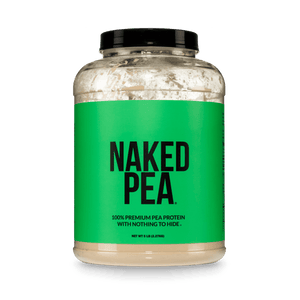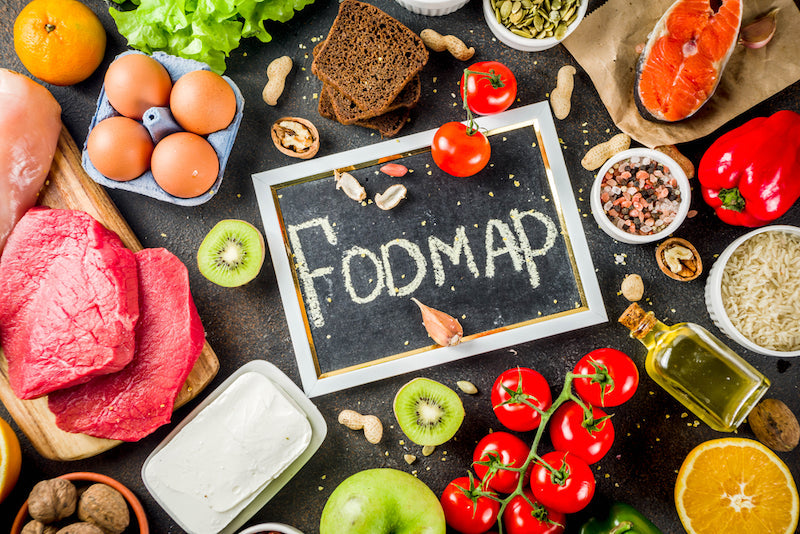
There are many people who suffer from gastrointestinal issues. In fact, the number of people who struggle with conditions like IBS, IBD, SIBO, and Celiac disease is on the rise. But why exactly is this the case and is there a way to improve symptoms?
The answer may lie in people’s varying abilities to tolerate FODMAPs.
This article will explain what FODMAPs are, the role they play in gut health, as well as who might benefit from temporarily eliminating them from their diet.
What are FODMAPs?
FODMAP is an acronym that encompasses a group of carbohydrates: fermentable oligosaccharides, disaccharides, monosaccharides, and polyols.
All of these carbohydrates are short-chain sugars that the digestive system sometimes has a more difficult time breaking down (1).
There are several common FODMAPs found in everyday foods. Fructose is a simple sugar found in many fruits and vegetables, as well as table sugar. Lactose is another FODMAP that is a carbohydrate found in dairy products.
Other FODMAPs include fructans which are largely found in grain products, galactans which are found in beans, and polyols which are sugar alcohols found naturally in some foods as well as in artificial sweeteners.
What Happens When You Eat High FODMAP Foods?

FODMAPs are short-chain carbohydrates that are resistant to digestion. This means that when someone consumes them, instead of being absorbed directly into the bloodstream, they travel to the large intestine where most of the gut bacteria live.
The gut bacteria use these FODMAPs for fuel and start to break down these carbohydrates. As a result of this breakdown process, the gut bacteria produce hydrogen gas. Hydrogen gas in the intestines can cause digestive symptoms such as bloating, stomach cramps, pain, diarrhea, or constipation in those with more sensitive systems.
Also, FODMAPs can draw water into the intestines, which can lead to diarrhea for those who are sensitive.
It’s important to recognize that not everyone has a sensitivity to FODMAPs, however, it is common among those with irritable bowel syndrome (IBS).
Sensitivity to FODMAPs is all very individualized. Even if someone is sensitive to some FODMAPs, it doesn’t mean they’re sensitive and will react to all FODMAPs. On the other hand, some individuals can eat a variety of high FODMAP foods and not experience any side effects at all (2).
What are the Benefits of Restricting or Eliminating FODMAPs from Your Diet?

Some people may benefit from temporarily either restricting or eliminating FODMAPs from their diet.
Some of the benefits of restricting or eliminating FODMAPs from the diet include reduced bloating and cramping and more regular bowel movements.
Not only can temporarily restricting or eliminating FODMAPs help determine which specific types of FODMAPs cause symptoms, but it can also be a way to experience relief from uncomfortable symptoms and improve quality of life.
However, most people are not sensitive to all FODMAPs, but rather select FODMAP groups such as fructans and lactose. That’s why a temporary restriction of some or all FODMAPs can be a helpful way to determine which kinds are tolerated, and which are not tolerated well (2).
Who Should Follow a Low FODMAP Diet?
It’s important to realize that most of the research has focused on low FODMAP diets in people with IBS, or for those who experience frequent gas, bloating, stomach cramps, diarrhea, or constipation. The research suggests that about 75% of people with IBS may benefit from following a low FODMAP diet (2).
In addition to IBS, a low FODMAP diet can be quite beneficial for those with other functional gastrointestinal disorders such as small intestinal bacterial overgrowth (SIBO).
IBS, SIBO, and other functional gut disorders present major challenges to healthcare providers and patients themselves as there are few medical therapies currently available to treat these conditions.
In fact, following a low FODMAP diet is often the gold standard protocol to get relief from symptoms (1).
It’s understood that consuming FODMAPs increases the presence of readily fermentable carbohydrates in the intestines which often leads to bloating and discomfort. So, if you’re someone who has been struggling with a functional gut disorder, you might find some relief in temporarily following a low FODMAP diet.
It’s important to note that a low FODMAP diet is not intended to be followed forever, as a low FODMAP diet tends to also be low in fiber, which gut bacteria actually need to survive and flourish.
Rather than following a low FODMAP diet forever, the intention is to narrow down some specific FODMAP-containing foods that are specifically giving rise to symptoms.
The following sections will outline different gastrointestinal conditions in which following a low FODMAP diet might be advised.
People With Irritable Bowel Syndrome (IBS)
Irritable Bowel Syndrome (IBS) is a common condition that causes irregular bowel movements and often comes about with many dietary sensitivities. Following a low FODMAP diet can sometimes be a way to improve or relieve symptoms for many people with IBS.
To Manage Small Intestinal Bacterial Overgrowth (SIBO)
SIBO is a condition of the gut in which bacteria that is typically supposed to be in the large intestine migrates up to the small intestine.
This movement of bacteria into the small intestine results in quite a bit of bloating, discomfort, and even pain. SIBO is often an issue that stems from poor motility.
When people have SIBO and they consume foods high in FODMAPs, symptoms tend to become exacerbated. When temporarily working to heal the gut from SIBO, it’s advised to temporarily follow a low FODMAP diet (3).
Those Diagnosed With Celiac Disease
Celiac Disease is a disease in which the immune systems become activated and inflamed when the intestinal cells are exposed to the protein gluten.
While those with celiac disease don’t necessarily have to avoid all FODMAPs, it’s important they avoid any FODMAP-containing food that also contains gluten. It’s important to note that gluten itself is not a FODMAP.
However, there may be certain FODMAPs in gluten-containing foods.
For example, wheat contains fructans and also contains gluten. Someone with a gluten allergy would need to avoid wheat but wouldn’t necessarily need to avoid all foods containing fructans.

What Foods are High in FODMAPs?
The following list includes some common foods that are high in FODMAPs:
- Fruits: apples, pears, peaches, figs, dates, ripe bananas, blackberries, and watermelon
- Vegetables: mushrooms, cauliflower, onions, garlic, leeks, artichokes, and asparagus
- Plant-based proteins: tofu, black beans, lentils, chickpeas
- Dairy products: milk, yogurt, soft cheeses, sour cream, whey-based supplements
- Grains: wheat products such as pasta, breads, many breakfast cereals, pastries, tortillas, as well as barley and rye
- Sweeteners: honey, sorbitol, xylitol, fructose, and high fructose corn syrup
The Phases of a Successful Low-FODMAP diet Plan

Elimination Phase
In the elimination phase of a successful low-FODMAP diet, it’s generally recommended to remove all high FODMAP foods for a period of two to three weeks.
To get the most relief from symptoms and best determine which FODMAPs you’re sensitive to, it’s necessary to be diligent about the protocol. It’s important to be aware that some low FODMAP foods if eaten in higher quantities will actually be considered a high FODMAP amount.
It can be tricky to navigate a low-FODMAP diet on your own, which is why it can be helpful to get support from an expert, such as a Registered Dietitian (RD) who is specifically trained in this area.
Plus, getting support from a nutrition professional may also help prevent you from unnecessarily eliminating certain foods from your diet.
While the elimination phase can be a bit challenging to figure out, it’s probably the most important part of the process.
All FODMAPs must be cleared out of the digestive tract in order to have a clean slate to work with for the reintroduction phases. If you’re in fact sensitive to high FODMAP foods, you may see improvement in symptoms pretty quickly from the elimination phase.
For some, it might feel tempting to stay in the elimination phase, especially if symptoms have improved significantly.
However, remember that it’s not recommended to stay off all FODMAPs long-term, as it can be quite restrictive and there are many benefits to consuming a variety of FODMAP foods as long as you’re not sensitive to them.
Reintegration Phase

After a period of two or three weeks — depending on how long you determine to follow the elimination phase — it’s time to start the reintegration phase of the protocol.
This phase allows people to discover which FODMAPs cause symptoms.
First, you’ll decide the order in which you’ll introduce each FODMAP group. If you completely eliminated all FODMAPs during the elimination phase, you’ll have a total of five FODMAP groups to reintroduce, one at a time:
- Fructans
- Fructose
- Lactose
- Galactose
- Polyols
Reintroducing one group of FODMAPs at a time and assessing the presence of symptoms will help determine which ones you are sensitive to.
You might find that you get unpleasant digestive symptoms when you eat foods that contain fructans. If this is the case, you may need to avoid all fructans, or perhaps you need to determine your threshold for these foods.
When reintroducing each FODMAP group, it’s best to try a small amount of food that only contains that FODMAP.
For example, if you’re trialing fructose, first test your tolerance with a spoonful of honey. If you try your tolerance to fructose with an apple, it won’t give you clear results since apples also contain fructans.
Determine a schedule for reintroduction that works best for you. Dedicate a full week to reintegrating each FODMAP group.
On day one, eat a small portion of the trial food. On day two, have a larger portion of the trial food, and on the third consecutive day include two separate servings of the trial food.
After the three days, assess for symptoms. If you experience symptoms at any point in the trial, stop the reintroduction and start the process over with a new food. In between trials, give your digestive system a two-day break of no new FODMAPs.
Customization Phase
Now that you know which FODMAPs you can and cannot tolerate, you can begin tailoring your diet to maximize your quality of life.
You can mix and match which FODMAPs you want to include at which meals. You might find yourself embracing a new sense of food freedom now that you don't have to worry about getting an upset stomach after eating, now that you know which FODMAPs work for you.
If you find yourself accidentally eating some higher FODMAP foods that you don’t tolerate so well, there’s no need to fret. You might experience some temporary digestive upset, but that will pass, and there’s no need to start the elimination phase over again.
You might also find that over time your digestive system gets better at tolerating FODMAPs. So, just because you might not be able to tolerate a particular FODMAP now, that doesn’t necessarily mean you’ll never be able to tolerate them.
Make Healthy Lifestyle Changes

The reason that anyone would explore a low FODMAP diet in the first place is to improve unpleasant digestive symptoms and help them feel their best.
In addition to exploring how FODMAPs might play a role in your physical health and well-being, there are so many other positive lifestyle changes that can have a dramatic impact on your health.
In addition to following a diet that is right for you, ensure you are integrating regular exercise, getting adequate sleep, and practicing stress management (4).
After all, there are so many factors that play a role in digestive health and it’s not as simple as an elimination diet. Be sure to pay attention to all of these other important lifestyle factors that will help you feel your best.
Proper Supplementation is Key
Taking the right supplements for your body is a great way to take your health to the next level. After discovering which FODMAPs you can and cannot tolerate, it’s advised to take a look at your supplement cabinet. Some supplements may be high in FODMAPs, like those containing lactose for example.
Taking supplements geared toward improving your digestion can aid in your low-FODMAP journey and assist with flare-ups and inflammation, especially during the reintegration stage.
You can incorporate some of our low FODMAP supplements to see what works best for you during the reintegration and customization phases.
Try the low FODMAP chocolate protein powder for a plant-based protein supplement that is totally FODMAP free. A damaged and sensitive gut often requires protein to heal and recover, which is why a protein supplement like this one might come in handy on your gut health journey.
Additionally, Naked Fiber is a great low-FODMAP supplement to boost your fiber intake. It’s a fiber powder sourced from the baobab plant which can help encourage a healthy bacterial balance in your gut.
An elimination diet often ends up being low in fiber which can actually negatively impact the bacterial balance in your intestines. However, something like Naked Fiber is a great way to encourage a healthy gut microbiome without causing unpleasant symptoms.

Find Alternative Solutions to Avoid Triggers
It can be a challenge to figure out a new way of eating to avoid your trigger FODMAPs. After all, FODMAPs are found in a wide variety of common foods.
In addition to careful planning for your new diet and lifestyle, finding easy ways to meet your nutrition needs can be a game-changer.
This is where gut-friendly, low-FODMAP supplements come in.
In addition to the ones mentioned above, supplements like Naked Gut can help you maintain robust gut health.













